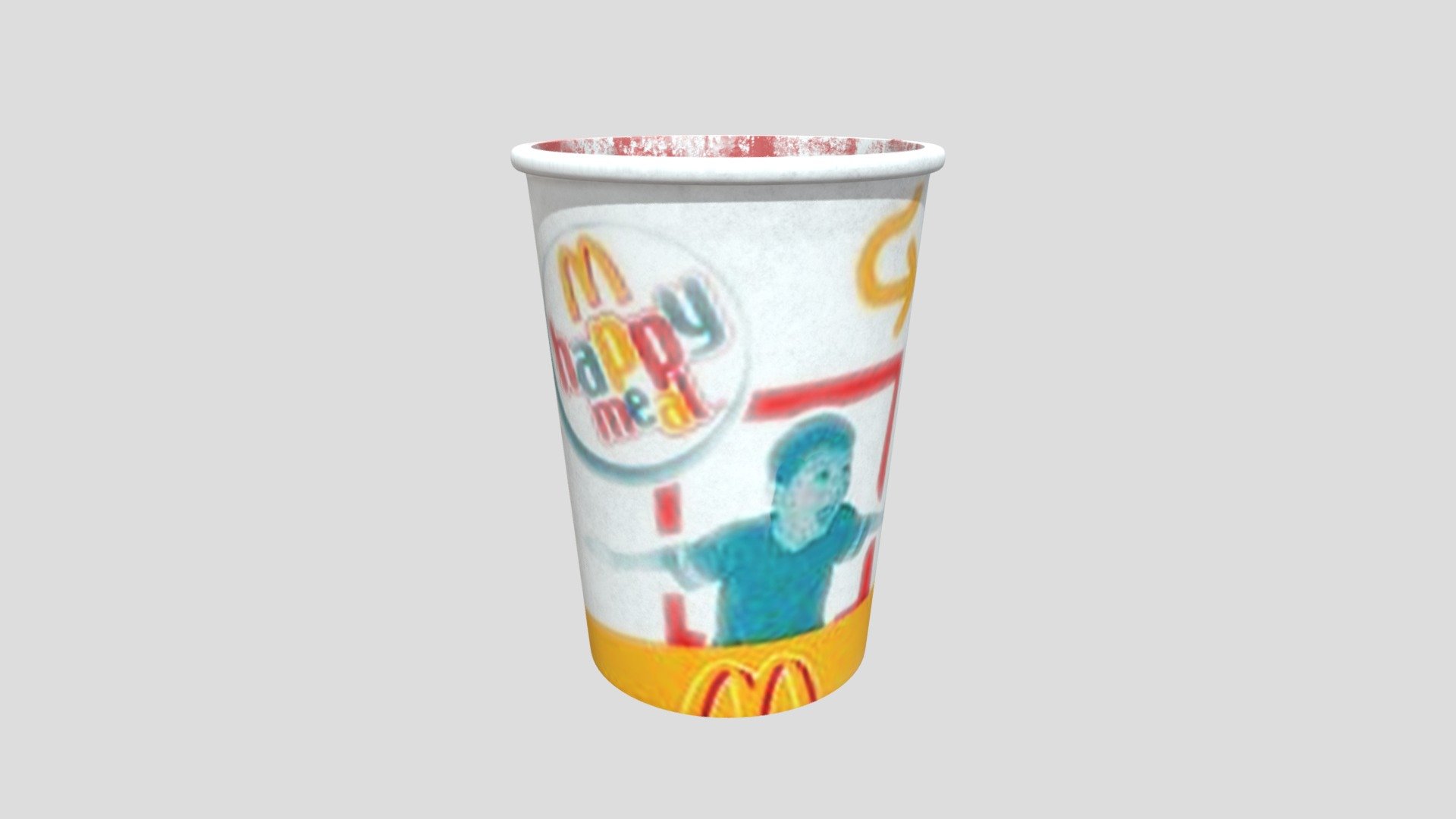McDonald’s Cup Design and Evolution: Mcdonalds Cups Meal

McDonald’s iconic red and yellow cups have become a familiar sight in restaurants and on streets around the world. The company’s cup design has evolved over the years, reflecting changes in branding, material technology, and consumer preferences.
Evolution of McDonald’s Cup Designs, Mcdonalds cups meal
McDonald’s cup designs have undergone a significant transformation since the company’s inception. Early cups were simple and functional, focusing on conveying basic information like size and beverage type. As the brand evolved, so did the cup designs, incorporating more elaborate graphics, logos, and marketing messages.
- Early Years (1940s-1960s): Early McDonald’s cups were primarily white with minimal branding. They featured the company’s name and a simple design, often with a red and yellow color scheme. The cups were primarily made of paper and were designed for practicality rather than aesthetic appeal.
- The Golden Arches Era (1960s-1980s): The introduction of the iconic golden arches logo in the 1960s marked a significant shift in McDonald’s branding. The cups began incorporating the arches prominently, often in a bold red and yellow color scheme. The designs became more playful and engaging, featuring cartoon characters like Ronald McDonald and other promotional campaigns.
- Modernization and Innovation (1990s-Present): In the 1990s, McDonald’s cup designs embraced a more modern and minimalist aesthetic. The golden arches logo remained prominent, but the cups featured cleaner lines, bolder fonts, and more sophisticated color palettes. The introduction of McCafe in the late 1990s led to the development of specialized cup designs for coffee and other specialty beverages, featuring different fonts, colors, and textures to reflect the premium nature of the offerings.
The Role of McDonald’s Cups in Marketing and Branding

McDonald’s cups are more than just containers for beverages; they are powerful marketing tools that play a crucial role in building brand recognition, fostering customer loyalty, and driving sales. The company leverages its cups to implement a variety of marketing strategies, effectively engaging customers and solidifying its position as a global fast-food icon.
The Cups as a Brand Canvas
McDonald’s cups are a prime example of how a seemingly simple product can be transformed into a powerful marketing tool. The cups are designed to be visually appealing, featuring the iconic golden arches and bold, recognizable colors. The brand’s name is prominently displayed, ensuring instant brand recognition and association with the familiar McDonald’s experience.
Promoting Brand Recognition and Customer Loyalty
McDonald’s cups contribute significantly to brand recognition and customer loyalty through several strategies:
- Consistent Branding: The use of consistent branding elements, such as the golden arches, color scheme, and font, across all cups reinforces brand identity and makes the cups easily identifiable.
- Memorable Designs: McDonald’s frequently introduces limited-edition cup designs, often tied to seasonal events, holidays, or popular culture trends. These unique designs create a sense of excitement and exclusivity, encouraging customers to collect them and share their experiences on social media.
- Customer Engagement: McDonald’s uses its cups to engage customers directly. They often include messages, promotions, or contests on the cups, encouraging customers to interact with the brand and participate in campaigns.
Leveraging Promotional Campaigns and Limited-Edition Designs
McDonald’s actively uses promotional campaigns and limited-edition cup designs to engage customers and generate excitement:
- Seasonal Campaigns: McDonald’s frequently releases limited-edition cups for holidays like Halloween, Christmas, and Valentine’s Day. These designs often feature festive themes, characters, or colors, creating a sense of celebration and encouraging customers to participate in the seasonal spirit.
- Collaborations and Partnerships: McDonald’s partners with popular brands and franchises to create limited-edition cups featuring their logos or characters. This strategy allows McDonald’s to tap into existing fan bases and create buzz around the collaboration. For instance, the “Stranger Things” themed cups released in 2022, featuring iconic characters and imagery from the popular Netflix show, generated significant social media engagement and drove sales.
- Promotional Offers: McDonald’s often includes promotional offers or coupons on its cups, encouraging customers to purchase additional items or visit the restaurant more frequently.
Social Media Integration and Online Marketing Efforts
McDonald’s has effectively integrated its cups into social media campaigns and online marketing efforts:
- Social Media Contests: McDonald’s often runs contests on social media platforms, encouraging customers to share photos of themselves with their limited-edition cups or participate in challenges related to the cup designs. These contests generate user-generated content, boosting brand visibility and engagement.
- Hashtags and Campaigns: McDonald’s uses specific hashtags related to its cup designs or promotional campaigns to encourage online conversation and create a sense of community among its customers. For example, the #McCafe hashtag has become synonymous with the brand’s coffee offerings and encourages customers to share their coffee experiences on social media.
- Influencer Marketing: McDonald’s collaborates with influencers to promote its limited-edition cups and engage their audiences. Influencers often feature the cups in their social media posts, reviews, and videos, reaching a wider audience and generating buzz around the designs.
Environmental Impact and Sustainability of McDonald’s Cups

McDonald’s, a global fast-food giant, serves millions of customers daily, generating a significant amount of waste, particularly from its disposable cups. The environmental impact of these cups, from their production to disposal, has become a growing concern. This section explores the environmental impact of McDonald’s cup production and disposal, examines the company’s efforts to reduce waste and promote sustainable practices, compares different cup materials, and details the recycling programs and initiatives implemented by McDonald’s to address cup waste.
Environmental Impact of McDonald’s Cups
The environmental impact of McDonald’s cups is multifaceted and encompasses various stages of their lifecycle, from raw material extraction to disposal.
Production
- Resource Extraction: The production of cups requires significant amounts of natural resources, including trees for paper cups and petroleum for plastic cups. This extraction process can lead to deforestation and habitat loss, contributing to climate change and biodiversity decline.
- Energy Consumption: The manufacturing of cups consumes substantial energy, leading to greenhouse gas emissions. The energy used for transporting raw materials, processing, and packaging contributes to air pollution and climate change.
- Water Consumption: The production of cups requires significant amounts of water for various stages, including pulp production for paper cups and plastic resin manufacturing. Water scarcity is a growing concern in many regions, and excessive water usage for cup production can exacerbate this issue.
Disposal
- Landfill Waste: A significant proportion of McDonald’s cups end up in landfills, where they take hundreds of years to decompose, contributing to soil and water pollution. Plastic cups, in particular, can leach harmful chemicals into the environment.
- Ocean Pollution: Mismanaged waste, including cups, can find its way into oceans, harming marine life and ecosystems. Plastic cups can entangle and suffocate marine animals, and their breakdown into microplastics poses a threat to the food chain.
- Greenhouse Gas Emissions: The decomposition of organic materials in landfills releases methane, a potent greenhouse gas, contributing to climate change.
McDonald’s Efforts to Reduce Waste and Promote Sustainability
Recognizing the environmental impact of its cups, McDonald’s has implemented various initiatives to reduce waste and promote sustainability:
Cup Material Innovations
- Paper Cups: McDonald’s has transitioned to using paper cups for most of its beverages, reducing reliance on plastic. Paper cups are generally considered more environmentally friendly than plastic cups as they are biodegradable and can be recycled in some cases.
- Recycled Materials: The company has incorporated recycled materials into its cup production, reducing the need for virgin materials. By using post-consumer recycled paper and plastic, McDonald’s aims to minimize its environmental footprint.
- Biodegradable and Compostable Cups: McDonald’s is exploring the use of biodegradable and compostable cups made from plant-based materials. These cups can break down in composting facilities, reducing landfill waste.
Comparison of Cup Materials
- Paper Cups: Paper cups are generally considered more environmentally friendly than plastic cups due to their biodegradability and recyclability. However, they often require a plastic lining to prevent leakage, which can complicate recycling. The production of paper cups can also have a significant environmental impact, particularly in terms of deforestation and energy consumption.
- Plastic Cups: Plastic cups are durable and lightweight, but they are not biodegradable and can persist in the environment for hundreds of years. The production of plastic cups relies heavily on fossil fuels, contributing to climate change and air pollution.
- Recycled Materials: Using recycled materials in cup production reduces the demand for virgin materials, minimizing the environmental impact of resource extraction. However, the recycling process itself can consume energy and water.
McDonald’s Recycling Programs and Initiatives
McDonald’s has implemented various recycling programs and initiatives to address cup waste:
In-Store Recycling
- Recycling Bins: McDonald’s restaurants have designated recycling bins for customers to dispose of their cups and other recyclable materials.
- Employee Training: Employees are trained on proper recycling procedures to ensure that cups and other recyclable materials are sorted correctly.
Partnerships and Collaborations
- Recycling Companies: McDonald’s partners with recycling companies to process and recycle the collected cups and other materials.
- Waste Management Programs: The company collaborates with local waste management programs to implement efficient waste collection and recycling systems.
Public Awareness Campaigns
- Recycling Education: McDonald’s runs public awareness campaigns to educate customers about the importance of recycling and proper waste disposal.
- Promotional Materials: The company uses promotional materials to encourage customers to recycle their cups and other materials.
Mcdonalds cups meal – The absurdity of our consumerist culture is on full display with the McDonald’s “Happy Meal” cups, a seemingly innocuous marketing ploy that reflects a deeper societal obsession with disposable goods. This obsession, unfortunately, extends beyond plastic cups and into the realm of our collective safety, as evidenced by the recent helicopter crash into a Hilton hotel.
Perhaps it’s time we reconsider the value we place on fleeting convenience and prioritize a more sustainable and responsible approach to our consumption habits, both in our fast-food choices and our broader societal choices.
The seemingly mundane act of ordering a McDonald’s meal, with its iconic red cups, might seem far removed from the complexities of international politics. Yet, the global reach of fast food giants like McDonald’s is a potent reminder of the interconnectedness of our world.
The recent developments in news iran highlight how even seemingly trivial aspects of our lives can be influenced by global events, from economic sanctions to political instability. And so, the next time you grab a McDonald’s cup, consider the intricate web of factors that have shaped its journey from production to your hands.
